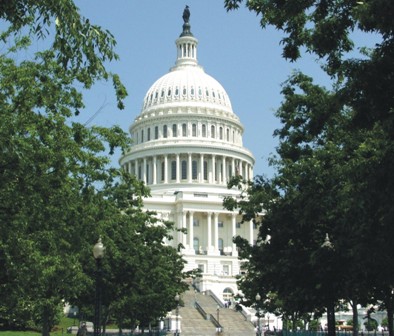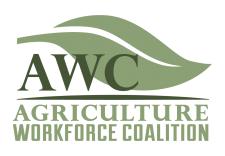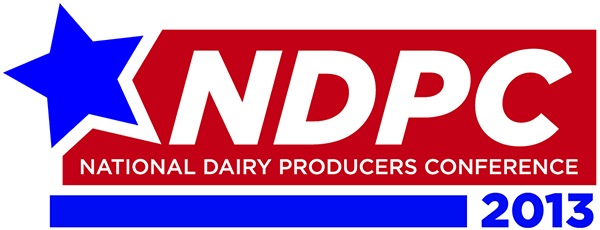Latest Congressional Estimate of Farm Bill Demonstrates Value of Dairy Security Act
March 08, 2013 Congress’ failure to pass a farm bill last year is proving costly. New preliminary cost estimates from the Congressional Budget Office (CBO) have revised upward the price tag of the farm bills that moved through the House and Senate last year. The bills still show budget savings over current farm programs – saving billions of dollars over a ten-year period – but the projected savings have been reduced by new economic projections.
Congress’ failure to pass a farm bill last year is proving costly. New preliminary cost estimates from the Congressional Budget Office (CBO) have revised upward the price tag of the farm bills that moved through the House and Senate last year. The bills still show budget savings over current farm programs – saving billions of dollars over a ten-year period – but the projected savings have been reduced by new economic projections.
CBO estimates that the Dairy Security Act (DSA), which was part of both the Senate-approved and the House Agriculture Committee-approved farm bills, will still provide a cost-effective safety net for America’s dairy farmers, but the new revisions project the program would cost slightly more than last year’s projection. CBO also reduced its “baseline” calculation of what current dairy programs would cost over the next five years if they were extended. Last year, CBO said current dairy law would cost $248 million during the 2013-17 period. Despite their new projection showing lower dairy market prices than in last year’s estimate, CBO’s new preliminary five year estimate of current dairy law fell from $248 to $161 million. Information released by CBO with the new estimates does not explain how current programs could be projected to cost less when the same projections indicate future lower milk prices.
Even with the new preliminary estimate, the dairy plan of margin protection and market stabilization represents less than one-twentieth of one percent of the cost of the overall farm bill. That is by far the lowest cost of any of the major farm commodities covered in the farm bill.
CBO now calculates that enacting the Senate-passed bill would bring total U.S. Department of Agriculture spending from 2014 to 2023 to $963 billion. The House bill would cost $950 billion over the same period. The Supplemental Nutrition Assistance Program, or food stamps, makes up roughly 80 percent of the legislation’s cost.
Immigration Reform Process Continues on Capitol Hill
March 08, 2013 NMPF continues to work with other national and state farm groups on reforms to America’s immigration policies that would allow for the future flow of workers on dairy farms and the opportunity for existing workers that may lack legal documentation to continue working on dairy farms.
NMPF continues to work with other national and state farm groups on reforms to America’s immigration policies that would allow for the future flow of workers on dairy farms and the opportunity for existing workers that may lack legal documentation to continue working on dairy farms.
NMPF, a founding member of the Agriculture Workforce Coalition (AWC), sent a letter to House and Senate leadership last week calling for support of immigration legislation that addresses agriculture’s unique labor needs. The letter was delivered as the House Judiciary Subcommittee on Immigration & Border Security held a hearing last Tuesday focused on the need for a new agricultural guest worker program.
The Senate and House may pursue separate legislative paths to immigration reform, and NMPF is talking with leaders in both chambers to ensure that whatever decisions are made will address the unique needs of dairy farms.
February Marks Another Big Month for CWT Export Assistance
March 08, 2013In February, Cooperatives Working Together (CWT) helped member cooperatives make 85 foreign sales of cheese, butter, and whole milk powder totaling 22.8 million pounds of product.
The 43 cheese sales assisted by CWT totaled 10.8 million pounds of cheddar, Gouda, and Monterey Jack cheese. The 40 butter sales amounted to 11.9 million pounds of product, while two sales of whole milk powder totaling 130,073 pounds were made as well.
This brought total CWT-assisted sales in 2013 to 30.1 million pounds of cheese, 21.6 million pounds of butter, and 218,258 pounds of whole milk powder. The milk equivalent of this amount was 749.1 million pounds, or the annual production of 35,600 cows.
CWT is a significant factor in exports of U.S. dairy products, accounting for 83% of American-type cheese exports and 18% of all cheese exports in 2012. CWT export assistance also accounted for 62% of all U.S. butter exports.
New USDA Survey of Pesticide Residues Finds No Problems in Milk
March 08, 2013The most recent national government survey looking for pesticide residues in foods found virtually no positive levels in milk, and none that exceeded government tolerance levels.
The U.S. Department of Agriculture (USDA) conducts an annual Pesticide Data Program annual survey to test various food commodities for pesticide residues. Each year, USDA and the Environmental Protection Agency jointly determine which commodities to test. In 2011, the USDA collected 743 whole milk samples in ten of the largest states, mostly at the retail level.
Overall, only five of the milk samples showed any presence of pesticide residue, and all were lower than Environmental Protection Agency-established tolerances for those compounds.
Annual Survey of Antibiotic Residues in Milk Finds Continuing Improvement
March 08, 2013 Dairy farmers continued in 2012 to improve their already stellar track record of keeping antibiotic residues out of the milk supply, with the most recent national survey finding that only 0.017% of all bulk milk tankers, or 1 in 6,000 loads, showed any sign of an animal antibiotic drug residue. On-farm vigilance in following drug withdrawal times has led to a steady decline in antibiotic residue, falling from an already low level of 0.061% in 2002, a decline of nearly 75% in the last decade.
Dairy farmers continued in 2012 to improve their already stellar track record of keeping antibiotic residues out of the milk supply, with the most recent national survey finding that only 0.017% of all bulk milk tankers, or 1 in 6,000 loads, showed any sign of an animal antibiotic drug residue. On-farm vigilance in following drug withdrawal times has led to a steady decline in antibiotic residue, falling from an already low level of 0.061% in 2002, a decline of nearly 75% in the last decade.
These figures are based on information reported to the Food and Drug Administration’s National Milk Drug Residue Data Base by state regulatory agencies under the National Conference on Interstate Milk Shipments (NCIMS). Data are reported on the extent of the national testing activities, the analytical methods used, the kind and extent of the animal drug residues identified, and the amount of contaminated milk that was removed from the human food supply.
All milk loads are tested for antibiotics, and any tanker which tests positive for a drug residue is rejected before entering a dairy plant and does not enter the market for human consumption. The full report is available online.
NMPF Backs Truck Weight Legislation
March 08, 2013Congressional legislation allowing states to increase the weights of trucks used on their interstate roads has the endorsement of NMPF, along with hundreds of other associations and companies.
Reps. Reid Ribble (R-WI) and Mike Michaud (D-ME) introduced the “Safe and Efficient Transportation Act (H.R. 612),” known as SETA, on Feb. 14. The legislation allows an increase to 97,000 pounds on interstates, provided that trucks which utilize the higher weight limit add an additional sixth axle in order to maintain the same stopping distance and weight distribution as trucks currently operating on interstate highways.
NMPF has been circulating a letter in support of the bill, and has signed on to another letter being circulated by the National Cattleman’s Beef Association with signatures from other agricultural organizations.
“This bill is one way Congress can help permit the industry to increase its efficiency, thereby keeping down one key cost in transporting milk and dairy products,” said Jerry Kozak, NMPF President and CEO, in a letter to Congress.
While the bill has received a large amount of bipartisan support, serious opposition remains to giving states the option to increase their truck weights on interstate highways. The SETA legislation failed to make it into the two-year authorization of highway funding passed last July. Instead, a study was commissioned to review the possible safety implications of such a change. The highway bill will expire on Sept. 30, 2014, and SETA will be likely to be a key point of debate in the reauthorization effort.
Dairy Groups Welcome Launch of U.S.-EU Negotiations
March 08, 2013NMPF and the U.S. Dairy Export Council (USDEC) welcomed the announcement last month that the U.S. and European Union (EU) will launch trade negotiations. The U.S. and EU stated that the planned Transatlantic Trade and Investment Partnership is intended to be a comprehensive agreement that addresses a broad range of bilateral trade and investment matters, including regulatory issues.
“NMPF believes that considerable potential exists for greater U.S. dairy exports to the EU, if the Transatlantic agreement effectively tackles not only market access issues but also the many nontariff barriers that have made it challenging for the United States to make more headway into the European dairy market,” said Jerry Kozak, president and CEO of NMPF.
“The U.S. dairy industry is now a major exporter globally. Despite this fact and the large size of the European dairy market, U.S. dairy exports to the EU have lagged and totaled only $88 million last year,” said Tom Suber, president of USDEC. “This is not because we can’t compete there, but because of the many tariff and regulatory hurdles facing our exporters seeking to enter the EU. The EU currently enjoys a dairy trade surplus with the United States of $1.2 billion. This is at a time when the United States is exporting $5.2 billion in dairy products around the world. We believe the Transatlantic agreement can do a lot to drive more reciprocal dairy trade between the United States and EU.”
In prior submissions to the Administration about U.S.-EU trade, NMPF and USDEC have noted that U.S. exports to the EU are hindered by significant tariffs, as well as sizable regulatory barriers such as requirements unrelated to food safety with respect to somatic cell count limits for imported dairy products, tariff-rate quota administration details, cumbersome mandates related to certificate dating, bans on the use of generic food names and other requirements. As a result, U.S. dairy sales last year to all 27 EU member states—home to over 500 million people—just barely edged out those to Singapore, a country well known for its commitment to free trade, yet home to just over 5 million people.
NMPF and USDEC also reiterated the need to ensure that any discussions on the use of common food names and geographical indications (GIs) be aimed at uprooting the rapidly expanding EU effort to erect de facto barriers to trade against U.S. products through granting GIs to many common food names.
National Dairy Producers Conference to Focus on Farm Bill, Immigration Reform Challenges
March 08, 2013 The outlook for a new farm bill, and a better safety net for dairy farmers, will be one of the key sessions at the upcoming National Dairy Producers Conference (NDPC) April 7 – 9 in Indianapolis, Indiana.
The outlook for a new farm bill, and a better safety net for dairy farmers, will be one of the key sessions at the upcoming National Dairy Producers Conference (NDPC) April 7 – 9 in Indianapolis, Indiana.
The conference, open to dairy farmers from across the country, will provide an in-depth discussion of the issues facing the dairy industry, with educational discussions on topics ranging from farm policy to immigration reform to agricultural finance. The meeting is organized by NMPF.
On Monday, April 8th, a two-hour session will address the prospects in 2013 for the NMPF-backed dairy reforms contained in the 2012 Farm Bill. That session will feature presentations from congressional staff, NMPF leadership, and agricultural economists – all discussing the outlook for getting the Dairy Security Act (DSA) passed this year, and how that measure would benefit farmers. Although the DSA came close to passage at the end of 2012, the agriculture committees in the House and Senate will have to restart the farm bill process this spring. The NDPC panel will review how that process will unfold, and will examine why a dairy margin insurance program with market stabilization will provide better financial protection for farmers compared to current programs.
“The National Dairy Producers Conference is the only forum where dairy farmers from across America can meet together and have in-depth discussions about the policy issues affecting them,” said Jerry Kozak, President and CEO of NMPF. “There’s no shortage of major challenges right now in our business. The focus of this conference is on addressing solutions for the future.”
In addition to reviewing the farm bill, the conference will include another session about the prospect for immigration reform legislation on Capitol Hill, with presentations from individuals representing dairy farmers, the White House and Congress. The National Dairy Producers Conference will also examine the state of the agricultural banking sector as it relates to dairy farming. A trade policy panel will address how the U.S. can both protect and promote its dairy products in world markets, while a panel on dairy cow marketing will focus on the marketing of cull dairy cows.
Guest speakers at the NDPC include Purdue agricultural economist Christopher Hurt, who will review the outlook for feed prices this year, and Bill Weldon of Elanco, who will discuss new ideas under development for products to enhance a dairy cow’s productivity.
The NDPC sessions will be preceded by an optional farm tour that will take place on Sunday, April 7th. Participants will be able to get an insider tour of Fair Oaks Farms, one of the largest dairies in the country, with a consumer education facility.
Although the conference is geared primarily toward dairy producers, anyone with a stake in the dairy industry is invited to attend. This may include dairy cooperative executives and directors, dairy processors, suppliers and consultants to the dairy industry, state and federal regulators, promotion organization executives, and academics.
The deadline to make hotel reservations is March 14th. For more information on the NDPC, including how to register, visit www.nmpf.org/NDPC.
New Report Highlights NMPF’s Achievements from 2012
March 08, 2013This week, NMPF released its 2012 Activities and Accomplishments Report, which recounts the organization’s various achievements throughout the past year. The report covers important issues such as dairy policy reform and the Farm Bill, tax and budget, food safety, nutrition, animal care, and trade. It also highlights activities of the NMPF membership, featuring the board of directors, member cooperatives, and Young Cooperators. The report will be distributed at NMPF’s board of directors meeting next week.
The report is available electronically on the NMPF website. Please contact Sarah Olson to request hard copies of the report.





